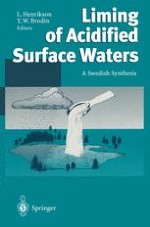1995 | OriginalPaper | Buchkapitel
Strategies and methods for freshwater liming
verfasst von : William Dickson, Y-W Brodin
Erschienen in: Liming of Acidified Surface Waters
Verlag: Springer Berlin Heidelberg
Enthalten in: Professional Book Archive
Aktivieren Sie unsere intelligente Suche, um passende Fachinhalte oder Patente zu finden.
Wählen Sie Textabschnitte aus um mit Künstlicher Intelligenz passenden Patente zu finden. powered by
Markieren Sie Textabschnitte, um KI-gestützt weitere passende Inhalte zu finden. powered by
Liming is an effective method to counteract the chemical and biological effects of acidification. Sweden and Norway are the only countries that maintain large-scale liming operations as a national strategy to restore ecological conditions in acidified lakes and watercourses. The number of limed surface waters in Sweden amounts to nearly 8,000. Several hundred surface waters are limed in Norway, while liming is conducted on a limited scale, i.e. less than 200 surface waters, in other countries.To counteract the total acidification of Sweden during the 20th century around 90 million tonnes of limestone are required. The cost of purchasing, transporting and dispersing this amount of lime is approximately 25 trillion Swedish krona (SEK)(c. USD 3 trillion), which can be compared with the rougly SEK 200 million presently used each year to lime surface waters in Sweden.The best form of liming is often a combination of methods. All liming operations require monitoring. Liming is a chemical form of treatment which achieves its optimal biological effects after a few years.In order to comply with the overall goal of Swedish liming activities, viz. to restore ecosystems to their natural conditions as far possible, full-scale liming of the catchment soil is the best method in the long term. This strategy, however, is rarely applied, mainly because of the high initial costs involved and the long time needed to achieve the desired effects in the surface water. To achieve adequate results in the runoff water, doses in southern Sweden of at least 5 t/ha of runoff area are needed. Total lime-stone uptake to the benefit of the surface water will after full-scale liming be perhaps 20% before the treatment needs to be repeated.Wetland liming is costly but seals metals such as iron, aluminium, and manganese before they reach the water. This method also suppresses the acid surges during high water periods which occur more frequently the more acid the soild and the wetland become. However, if there are suitable discharge areas, liming of 1–2% of the runoff area could be effective for at least a couple of years. The first liming dose can be limited to approximately 300 kg/ha of runoff area and the annual doses can be subsequently reduced by approximately 100 kg/ha of runoff area. The doses on the limed wetland areas are neverheless significant: 10–30 t/ha. The total lime exploitation can be in favourable cases be 50–70%, but it is often significantly lower. Harmful effects on wetland vegetation can occur.Lake liming is the most common and cheapest method for liming surface waters in Sweden and other countries. It is the only method used when the lake area percentage is more than 10%. However, the method cannot cope with acid surges from unlimed areas in catchment areas close to the lakeside. The duration of lake liming is mostly a few years. In lakes with a retention time of less than 1 year, the duration is often equivalent to 4–5 turnovers, while the duration in lakes with a retention time of several years is equivalent to 2–3 turnovers. The total assimilation of added lime or sodium carbonate is often 50–80%.Doser liming can be an effective and cheap method of treating running waters and lakes with short turnover times. Around 300 lime dosers were in operation in Sweden in 1993. The dosers require regular checks and should be located several metres upstream from the primary liming object. They must be located where they can be refilled and the annual dosage must be so high that the price of the doser can be justified. The total uptake of lime can be regulated and should therefore normally be high, 70–90%.A number of other liming methods or strategies to mitigate acid conditions in surface waters are available, i.e. road liming as an alternative to salting to reduce skidding, lime precipitation in wastewater treatment plants, ditch liming, and spreading of coarsely ground lime into watercourses. These methods can be used to complement the methods described above, but they presently contribute less than 1 % of the lime added to acidified freshwater in Sweden.A number of agents to increase pH and alkalinity of surface waters are available. In Sweden, limestone (CaC03) or dolomite (CaMg(C03)2) are used in more than 95% of all liming operations. For treatment of surface waters, limestone powder in fractions of 0–0.5 mm for lakes, more finely ground for dosers and slightly coarser fractions for wetlands are probably optimal in the light of price, dispersion qualities, dissolution and duration. Sodium carbonate (Na2C03) is used in some Swedish lakes.Thousands of tonnes of basic products from food production, egg and mussel shells, and sludge from sulphate pulp production are currently being dumped. Many of the products meet the purity requirements and should be used to lime forest soils. Over a period of a few years, this would have an effect on the runoff water.There are no satisfactory alternative methods to liming, but other measures can be complementary partcularly in order to counteract nutient depletion in the surface water, e.g. increased numbers of deciduous trees, spreading of ash formed when burning biofuels, and addition of treated wastewater.
